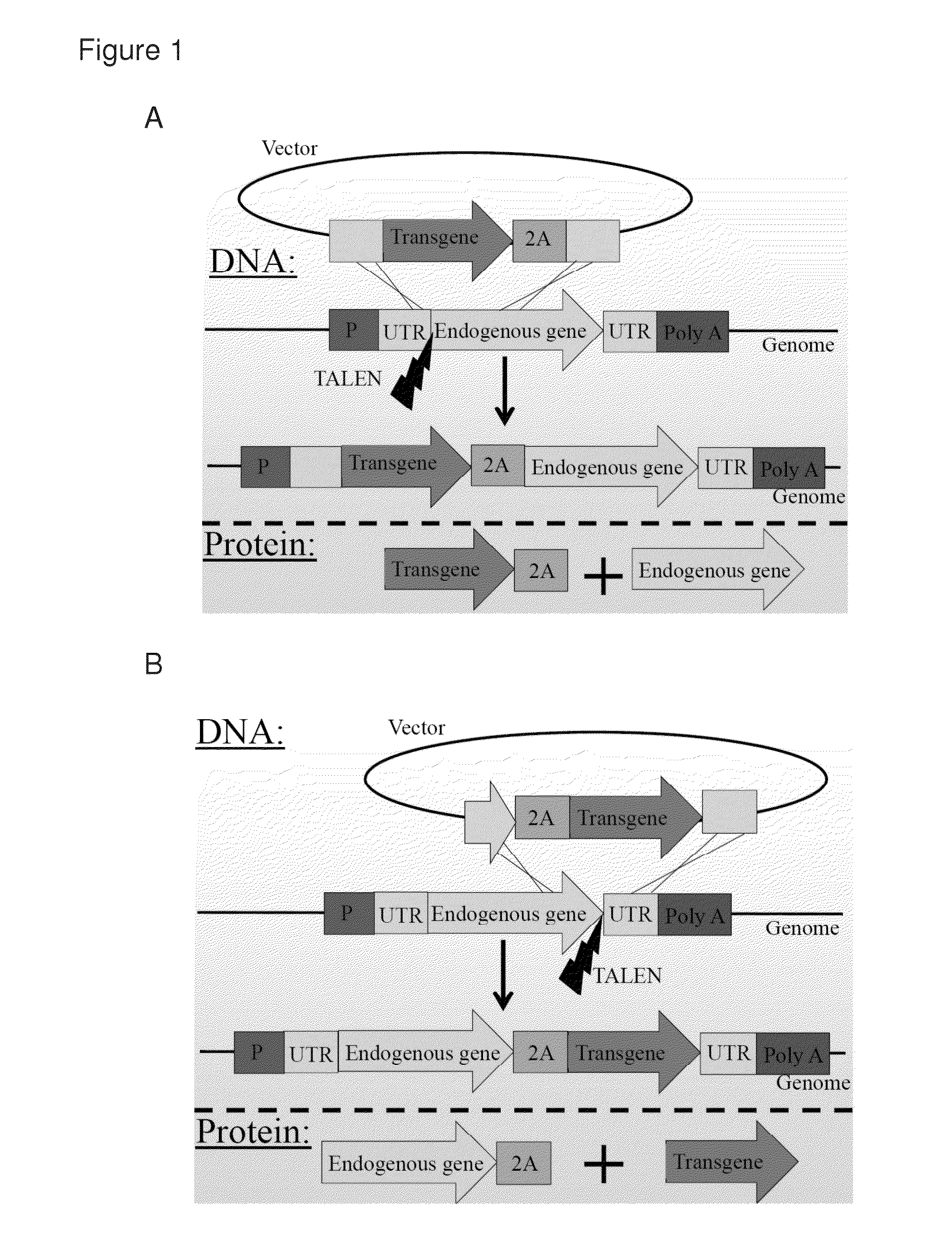Non-disruptive gene targeting
a technology of non-disruptive gene and target gene, which is applied in the field of non-disruptive gene targeting, can solve problems such as unwanted cell effects, and achieve the effect of promoting neuroprotective factor integration
- Summary
- Abstract
- Description
- Claims
- Application Information
AI Technical Summary
Benefits of technology
Problems solved by technology
Method used
Image
Examples
example 1
Targeting 2A-Fusions to Endogenous Genes
[0151]2A-peptides allow the translation of multiple proteins from a single mRNA by inducing ribosomal skipping. TALENs were used to induce the targeting of transgenes fused to 2A peptides just 3′ to endogenous reading frames (FIG. 1C). This approach has several advantages over the common use of expression cassettes including promoter and terminator. First, as the transgene does not bring with it any promoter, the chance of off-target oncogene activation is diminished. The transgene is not expressed from the vector but only if and when integrated in-frame downstream to an endogenous promoter. This happens essentially only if integration by homologous recombination is induced at the intended target. Importantly, once integrated, the expression of the transgene is co-regulated with that of the endogenous gene at the levels of transcription, splicing, nuclear export, RNA silencing and translation. While the endogenous gene product ends up having a...
example 2
Zinc-Finger Nuclease and TAL Effector Nuclease Mediated Safe Harbor Gene Addition without Safe Harbor Gene Disruption in Mouse Primary Fibroblasts
[0153]Nuclease-mediated safe harbor gene addition strategies are promising as next generation gene therapy technology. Heretofore, “safe harbors” have been defined as loci that can be disrupted without physiologic consequence and which carry no oncogenic potential when disrupted. In this study, homologous recombination-mediated safe harbor targeting does not require disruption of the endogenous gene product. In short, DNA which results in the same amino acid sequence as the target locus, but is non-homologous to the target locus by modification of the wobble position within multiple codons, can be targeted in-frame to result in no protein deficiency from the safe harbor.
[0154]To demonstrate the feasibility of this strategy, a previously described GFP reporter assay was used (Connelly et al Mol Ther 2010). In this assay, a GFP gene which ca...
example 3
Integrating Multiple Genes at the CCR5 Locus to Stack Genetic Resistance to HIV
[0157]One of the major challenges in developing therapeutics for HIV is the virus's ability to mutate and thereby evade therapy. The recent demonstration that zinc finger nucleases (ZFNs) can be used to mutate the CCR5 gene to create a population of HIV resistant T-cells or hematopoietic stem cells, phenotypically mimicking the CCR5 D32 allele, raises the possibility that precision genome engineering can be used to modify the course of HIV infection. The potential weakness of this approach is that in a patient infected with both CXCR4 and CCR5 tropic virus, simply mutating CCR5 in a fraction of T-cells probably will not be sufficient to alter the course of the disease. Instead, cells that are multiply genetically resistant to HIV need to be created. One method to safely and robustly stack genetic resistance to infection is by using ZFN-mediated homologous recombination to target a cocktail of anti-HIV fac...
PUM
| Property | Measurement | Unit |
|---|---|---|
| Current | aaaaa | aaaaa |
Abstract
Description
Claims
Application Information
 Login to View More
Login to View More - R&D
- Intellectual Property
- Life Sciences
- Materials
- Tech Scout
- Unparalleled Data Quality
- Higher Quality Content
- 60% Fewer Hallucinations
Browse by: Latest US Patents, China's latest patents, Technical Efficacy Thesaurus, Application Domain, Technology Topic, Popular Technical Reports.
© 2025 PatSnap. All rights reserved.Legal|Privacy policy|Modern Slavery Act Transparency Statement|Sitemap|About US| Contact US: help@patsnap.com



